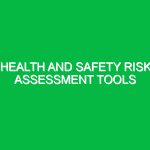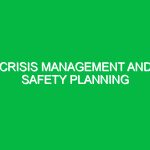Introduction
In the realm of industrial operations, the concept of safety management plays a vital role in ensuring the well-being of workers, the environment, and the overall efficiency of operations. Safety Management in Industrial Operations refers to the systematic approach taken to identify, evaluate, and mitigate risks associated with workplace hazards. This involves a blend of policies, procedures, and practices designed to minimize accidents and incidents, thereby fostering a culture of safety that aligns with Health, Safety, and Environment (HSE) principles.
The relevance of safety management within the HSE domain cannot be overstated. In industries ranging from manufacturing to construction, the potential for workplace hazards is omnipresent. A single lapse in safety protocols can lead to catastrophic consequences, not only for the individuals directly involved but also for the organization as a whole. The industry has witnessed numerous incidents where inadequate safety measures resulted in loss of life, environmental damage, and significant financial repercussions. Thus, effective safety management is not merely a regulatory obligation; it is a fundamental component of sustainable industrial practice.
Understanding Hazards and Risks in Industrial Operations
Identifying Potential Hazards
In the context of safety management, it is essential to distinguish between hazards and risks. A hazard is any source of potential damage or adverse effect, while risk is the likelihood that a hazard will cause harm. Industrial operations present a myriad of potential hazards, which can be broadly categorized into physical, chemical, biological, ergonomic, and psychosocial hazards.
1. **Physical Hazards**: These include machinery, equipment, and environmental factors such as noise, vibration, and slips, trips, and falls. For instance, in a manufacturing plant, moving machinery poses a significant risk if not properly safeguarded.
2. **Chemical Hazards**: Chemicals used in industrial processes can be toxic, flammable, or reactive. An example is the use of solvents in paint manufacturing, which can emit harmful vapors if not handled in ventilated areas.
3. **Biological Hazards**: Workers in certain industries, such as healthcare or food processing, may be exposed to bacteria, viruses, or allergens. For example, a food processing plant must implement strict hygiene protocols to prevent foodborne illnesses.
4. **Ergonomic Hazards**: Poor workstation design can lead to musculoskeletal disorders. In warehousing, improper lifting techniques can result in back injuries.
5. **Psychosocial Hazards**: Workplace stress, harassment, and long hours can affect mental health. Companies must recognize that employee well-being extends beyond physical safety.
Assessing Risks
Once hazards are identified, assessing the associated risks is crucial. This involves analyzing the likelihood of an incident occurring and the potential severity of its consequences. For example, in a chemical manufacturing facility, the risk of a chemical spill can be assessed based on the amount of hazardous material present and the effectiveness of spill containment measures.
Implementing Safety Precautions and Best Practices
Developing a Safety Management Plan
A robust safety management plan is the cornerstone of effective safety management in industrial operations. This plan should outline the organization’s commitment to health and safety, define roles and responsibilities, and establish clear procedures for hazard identification, risk assessment, and incident reporting. Regular training sessions should be conducted to ensure that all employees are familiar with safety protocols and emergency procedures.
Conducting Regular Safety Audits
Regular safety audits are essential for maintaining compliance with safety standards and regulations. Audits help identify areas for improvement and ensure that safety management practices are being followed. These audits should include a thorough inspection of equipment, work areas, and employee adherence to safety protocols.
Promoting a Safety Culture
Fostering a culture of safety within an organization is paramount. Employees should feel empowered to report unsafe conditions without fear of reprisal. This can be achieved through open communication channels, regular safety meetings, and recognition programs that reward safe behaviors.
Utilizing Technology and Automation
Technological advancements have significantly enhanced safety management capabilities. For instance, the use of automation in hazardous environments can reduce the risk to human workers. Additionally, wearable technology can monitor vital signs and detect environmental hazards, providing real-time feedback to enhance safety.
Emergency Preparedness and Response Plans
Every industrial operation should have a well-defined emergency preparedness and response plan. This plan should outline procedures for various types of emergencies, including chemical spills, fires, and natural disasters. Regular drills should be conducted to ensure that employees know how to respond effectively in an emergency.
Regulations and Standards in Safety Management
Safety management in industrial operations is governed by a variety of regulations and standards designed to protect workers and the environment. Key regulations include:
1. **Occupational Safety and Health Administration (OSHA)**: In the United States, OSHA sets and enforces safety standards to ensure safe working conditions. Compliance with OSHA regulations is mandatory for most industries.
2. **Environmental Protection Agency (EPA)**: The EPA regulates the handling and disposal of hazardous substances, ensuring that industrial operations do not harm the environment.
3. **ISO 45001**: This international standard provides a framework for occupational health and safety management systems, helping organizations improve employee safety, reduce workplace risks, and create better, safer working conditions.
4. **National Fire Protection Association (NFPA)**: NFPA standards focus on fire prevention and safety measures in industrial operations, ensuring that companies are prepared for fire-related emergencies.
Real-Life Examples and Case Studies
To illustrate the importance of safety management, consider the case of a major oil refinery that experienced a catastrophic explosion due to a failure in safety protocols. An investigation revealed that regular maintenance checks had been overlooked, and the safety management system was not effectively communicating risks. As a result, the incident led to multiple fatalities and extensive environmental damage. This tragedy underscored the need for stringent adherence to safety management practices and highlighted the potential consequences of neglecting safety.
Conversely, a manufacturing company that implemented a comprehensive safety management plan saw a significant reduction in workplace accidents. By fostering an open safety culture and investing in training, the company empowered employees to take an active role in identifying hazards, leading to a safer working environment and increased productivity.
Conclusion
Safety Management in Industrial Operations is not merely a regulatory requirement; it is a foundational element that contributes to the sustainability and success of an organization. By identifying hazards, assessing risks, and implementing effective safety precautions, companies can protect their workforce, minimize environmental impact, and ultimately enhance operational efficiency. The journey towards a safer workplace is ongoing, requiring commitment, vigilance, and an unwavering focus on continuous improvement. As the industrial landscape evolves, so too must our strategies for safety management, ensuring that health, safety, and environmental considerations remain at the forefront of industrial operations.


